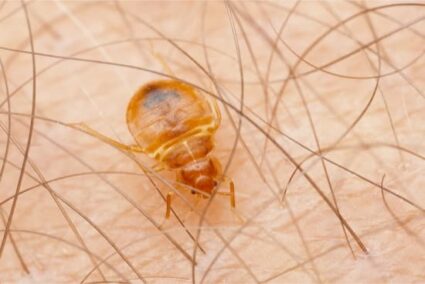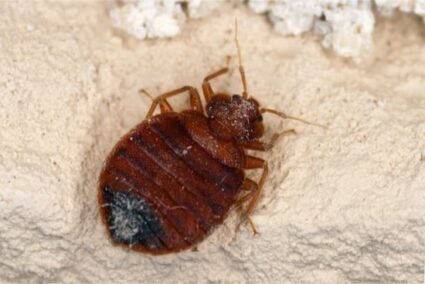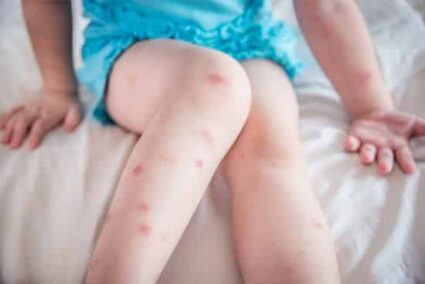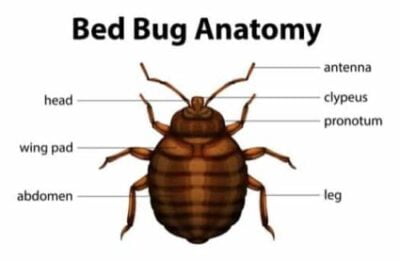If you’re afraid that your home might be infested with bed bugs, don’t panic. You might be worrying over nothing, as many bugs are often confused with bed bugs. If you do have an infestation, though, it’s essential to identify them so that you can seek out the appropriate treatment.
Bed bugs are small, reddish-brown, oval-shaped insects. They are 4mm – 7mm long, and loosely resemble apple seeds. Bed bugs have six legs, short antennae, and segmented bodies. Their bodies are flat when unfed, and swollen after a blood meal. Nymphs are small and pale, and eggs are tiny and white.
This article will help you to spot a bed bug infestation. We’ll discuss what bed bugs are, what they look like, and their distinguishing features. We’ll also cover how to identify bed bug nymphs, eggs, feces, and bite marks.
What Are Bed Bugs?
Bed bugs are insects in the order Hemiptera, or “true bugs.” They are loosely related to stink bugs, aphids, and even cicadas.
However, rather than innocently feeding on plant juices or sap, bed bugs have a more sinister idea of a good meal: they only drink human blood.
They are parasites, and cannot survive without feeding on warm-blooded animals, much like fleas or lice. However, bed bugs do not live directly on or in our bodies. Instead, they live in our beds, bedroom furniture, carpets and rugs, walls, and even electronics. At night, while we’re asleep, they follow our scent and settle down to feed.
A bed bug’s bite does not hurt at first, because their saliva contains an anesthetic, which stops us from feeling it. However, a few days after the bite, it turns into a small, very itchy red lump.
Bed bugs breed and reproduce quickly. One female can produce up to six eggs per day, according to a study in the scientific journal Insects. A small infestation can turn into a large one quickly.
Where Do Bed Bugs Come From?
Since 2004, the population of bed bugs in the USA has exploded into an epidemic. Every state in the U.S. is now home to bed bugs, and you can pick them up almost anywhere.
Hotels, movie theaters, friends’ homes, residential homes, hospitals, and even schools may be playing host to the parasitic creatures. It only takes one pregnant female to sneak into your coat pocket or your purse for you to bring a whole new generation of bed bugs home with you.
The first step toward dealing with an infestation is being able to identify bed bugs accurately.
What Does a Bed Bug Look Like?
One of the most common myths regarding bed bugs is that they are too small to see clearly. But can you see bed bugs with the naked eye? Surprisingly, you can – they are more than large enough, especially the adults.
If you find a small, mysterious bug in your home and you’re not sure whether it’s a bed bug, try to capture it in a clear glass. Then, you can begin examining it.

How Big Are Bed Bugs?
Adult bed bugs are around 4mm – 5mm long when unfed, and can grow to 7mm long when they have recently consumed a blood meal. Their bodies stretch and swell to accommodate their food.
If you’ve ever seen an apple seed, then you know what to look out for when identifying bed bugs. They are approximately the same size. They are also a similar shape – they have an oval-shaped abdomen and a small head.
What Color Are Bed Bugs?
Interestingly enough, bed bugs are about the same color as an apple seed, too. They are a deep, rich reddish-brown. The best way to describe the color of a bed bug is “mahogany.”
The brown color comes from the layers of their tough exoskeleton, which become darker at every stage in their life cycle. The red tint comes from their foodstuff of choice – blood.
When a bed bug has recently consumed a blood meal, they will be a brighter red color than usual.
Identifying Features of Bed Bugs
Like all insects, bed bugs have three main parts to their body:
- Head. A bed bug’s head is very small, with one tiny eye on each side, and a sharp “beak.” They have a long proboscis for drinking blood, which they keep tucked underneath their bodies when not in use. Bed bugs also have two antennae, which are quite short – about as long as their first pair of legs.
- Thorax. The next section of a bed bug’s body is the thorax (midsection), which is also tiny.
- Abdomen. A bed bug’s abdomen is about four times as long as the thorax, and twice as wide. The abdomen is round when viewed from above. If a bed bug hasn’t recently fed, its abdomen will appear flat when viewed side-on. When it feeds on blood, the abdomen will become plump and elongated.
A bed bug’s body is segmented. There are two small, rudimentary “wing casings” near the thorax. These are a functionless evolutionary remnant from a time long ago, when bed bugs could fly. Luckily, they can’t anymore – so if your bug takes off, it’s not a bed bug.
Bed bugs also have six legs. Viewing from above, the first pair of legs extends out from the thorax, and the second and third pairs extend out from the abdomen. Each leg has one bend, and ends in a foot with microscopic hooks, for gripping human skin.
Male vs. Female Bed Bugs
It is possible to tell the difference between a male bed bug and a female bed bug, though it’s quite tricky. The difference is all in the abdomen.
Female bed bugs are much rounder than males. Males are slightly more elongated and slim, even when unfed. However, the difference is subtle.
The obvious difference can be found at the tip of the abdomen. Female bed bugs are almost completely smooth and rounded, whereas males have a pointed tip. This is where the male sex organ is.
How to Identify a Bed Bug Nymph
The word “nymph” is used to refer to bed bugs that have not yet reached the adult stage of their life cycle.
Once a bed bug hatches from the egg, it emerges as a nymph. Nymphs start extremely small – around 1.5mm long. They are off-white in color.
Their shells are quite thin, so you can see through to their stomach quite easily. It will appear as a dark dot when unfed. After a blood meal, it will be bright red and engorged.
Nymphs look very similar to adult bed bugs, other than size and color. They have the same general body shape and number of legs. They go through 5 different stages of growth, called instars, before they reach full adulthood.
At each stage, the bed bug will get slightly bigger and slightly darker in color: cream, then honey, then pale brown, and eventually mahogany.
Between each stage, the nymph will molt and shed its exoskeleton (“skin”), to allow room for more growth.
Identifying Shed Bed Bug Skins
If you know how to recognize bed bugs, then you’ll also know what shed exoskeletons look like. When a bed bug sheds its skin, the whole thing comes off in one go.
The shells look almost exactly like the bugs themselves – you’ll be able to see the legs and the head. However, they are much paler in color, and of course, they are empty. If you poke one, it won’t start crawling away.

How to Identify a Bed Bug Egg
Now that you know how to recognize the bugs themselves, you might be wondering: can you see bed bug eggs?
Yes, you can – but you might have great difficulty. Bed bug eggs are very small – less than 1mm long. They are not technically microscopic, as they can be seen with the naked eye.
However, because they’re so tiny, they’re easily missed. And if you don’t have the best eyesight, you may not be able to see them at all.
Bed bug eggs are long and oval in shape. Picture a piece of uncooked short-grain rice, only much smaller. They are whitish in color, and slightly translucent as the shells aren’t very thick.
You’ll usually find bed bug eggs stuck to surfaces around your home with a sticky, glue-like substance that bed bugs produce. Usually, bed bugs tend to lay their eggs in the smallest, most secluded spots they can find. You’ll have to go searching with a magnifying glass and a flashlight to have any hope of finding them.
Bed Bug Egg Casings
Egg casings are the shells of bed bug eggs that baby bed bugs have already escaped from. They look very similar to bed bug eggs, but they are flatter and almost completely clear. They are even harder to spot than the eggs themselves, but they can be found in the same places.
If you find any, that’s a sure sign that baby bed bugs are lurking somewhere nearby.
How to Identify Bed Bug Feces
Like all living things, bed bugs have to expel waste from time to time. Bed bugs eat solely blood, so they also poop blood.
But the blood that makes up bed bug excrement has been digested, so it looks very different to the kind of blood that you’ll see if you accidentally cut yourself.
Blood that has been digested by bed bugs is very dark – almost black in color. It remains liquid in texture, so if a bed bug poops on something porous (like your mattress), the feces will sink into the fabric. This leaves a mark that looks like a small, flat black dot – very similar to ink spots from a pen.
These fecal spots will occur anywhere that they congregate, live and breed. Prime spots include:
- In the piping along the edges of the mattress
- Cracks and crevices in the headboard, box spring or bed frame
- Around the edges of the bedroom, including in the carpet, on the wall and baseboard
- Curtains, rugs or even stuffed animals.
Bed Bug Feces vs. Blood Spots
Another telltale sign of a bed bug infestation is blood spotting. This is different from bed bug feces because it is fresh blood that has not passed through a bug’s body.
Blood spotting occurs because bed bugs inject you with an anticoagulant when they bite. This stops your blood from clotting. A bite wound may bleed for some time after a bed bug has drunk its fill and unlatched. Also, you may sometimes roll over and crush a bed bug in your sleep, causing undigested blood to leak out.
You might find blood spots on the inside of your pajamas, on your bedsheet or your comforter. They’ll be lighter in color than fecal spots, and more uneven shape.
How to Identify a Bed Bug Bite
As well as identifying the bugs, eggs, and fecal spots, there’s one other telltale sign of an infestation: bite marks on your body.
Bed bugs usually bite at night. This is because we are mostly motionless while we’re sleeping, so there’s less chance of us moving around and dislodging the bed bug.
You may not notice bite marks straight away. This is because it can take several days for your skin to develop a reaction. The bite wounds themselves are tiny and invisible – but most people are allergic to bed bug saliva, which is what causes the welt. Bed bug bite marks are usually:
- Roundish, sometimes with uneven edges
- Raised and swollen
- Pink or red
- Very itchy, or even painful
Usually, bed bug bites appear in lines. Each bug will only take one meal per night, but sometimes the bug cannot find a suitable capillary to feed on, so has to unlatch and bite again. And of course, more than one bug may feed per night.
Bed bug bites occur most often on exposed skin, such as the feet, ankles, neck, and arms. However, they can crawl through gaps in your pajamas to bite the skin underneath. Bed bugs cannot bite through your clothing.
Be aware, though, that some people do not experience any bed bug bite symptoms. You may be being bitten and be completely oblivious, because your skin does not react.

What Bugs Can Be Mistaken for Bed Bugs?
Bed bugs are far from the only creepy crawlies that can infest your home, bite you and cause a nuisance. There are lots of similar-looking bugs, and parasites that cause similar reactions to bed bug bites.
Spider Beetles
Spider beetles aren’t related to spiders. They are insects, and only have six legs – through their antennae are so long that they can sometimes look like an extra pair of legs.
There are many species of spider beetle, but the one that looks most similar to bed bugs is the smooth spider beetle. They are oval, red-brown and about the same size. Spider beetles don’t bite humans – they feed on plant matter.
Spider beetles aren’t segmented like bed bugs. They have smooth, shiny, plump bodies. Their antennae are much longer than bed bugs’ – about as long as their whole body. Spider beetles’ legs are very long, and a yellowish-tan color.
Carpet Beetles
Carpet beetles come in various shapes, sizes, and colors. They are six-legged beetles with short antennae, like bed bugs. Rather than biting humans, though, carpet beetles feed on fabric. They infest carpets and other soft furnishings.
You can tell a bed bug from a carpet beetle by their body. Carpet beetles are longer and less round than bed bugs – they are more pill-shaped. Their bodies are covered by two shiny wing casings, so they do not appear segmented. Most carpet beetles are pale brown or mottled with brown, black and white. Their larvae are furry, and almost look like tiny caterpillars.
Cockroaches
You’ll probably have seen an adult cockroach before. They are much, much larger than bed bugs at about 4cm (1.6 inches). However, cockroach nymphs are often mistaken for bed bugs. They are small, reddish-brown, and have segmented bodies.
There are two main ways to tell cockroach nymphs apart from bed bugs. Firstly, they have extremely long antennae, longer than their entire bodies. Secondly, their bodies are much longer and narrower.
Cockroaches feed on any organic matter they can find, like starches, meats, and plants. They can even eat books! If their food supply runs short, they may bite humans, though this is rare.
Booklice
Booklice, also called barklice, are not true lice. They aren’t parasites – they feed on fungus, mold, and starches (such as the glue used to bind books). Booklice don’t bite humans or pets, but they can be a nuisance.
Like bed bugs, booklice have segmented bodies and six legs. They are not as dark as bed bugs, though – they are cream to pale brown in color. They have long antennae and much larger heads and thoraxes than bed bugs. Their abdomens are narrower and not as large.
Scabies
You can’t see scabies mites with the naked eye – they are much, much too small. The largest males look like tiny white pinpricks. However, their bites do produce very similar symptoms to bed bugs.
Scabies mites are parasites that live and feed on human skin. A scabies rash comprises many tiny bumps that look like pimples, and are itchy. Sometimes, you can even see the “tunnels” that they dig through the skin. A doctor will be able to identify a scabies rash and recommend treatment.
Fleas
Finally, fleas are often mistaken for bed bugs. In particular, their bite marks are mistaken for bed bug bites. They produce similar looking red, swollen welts that itch and sting.
Fleas are very easy to tell apart from bed bugs, though. They are much, much smaller, with very long back legs and no antennae. A flea viewed from above is very skinny, rather than round like a bed bug. Most importantly, they jump, whereas bed bugs don’t.
It’s rare that fleas will live on humans, so if you have them, you probably have a cat or dog that needs to see a veterinarian.
What Can I Do to Get Rid of Bed Bugs?
By now, you should be an expert at identifying bed bugs and spotting signs of an infestation. You should be able to tell bed bugs apart from similar insects and parasites with ease.
If you have discovered bed bugs in your home, call a professional exterminator for a consultation. Be sure to select a company experienced with bed bugs.
Some exterminators offer the initial examination for free, or deduct its cost from any future treatment. However, most charge a fee.
It’s worth it, though. An exterminator will be able to estimate the size of the population, and a quote for the price of treatment.
There’s only one guaranteed way to deal with an infestation: heat treatment. This can only be carried out by a professional. It involves warming your entire home to over 140 degrees Fahrenheit – a fatal temperature for bed bugs, according to research by the University of Minnesota. This temperature kills all bugs, nymphs, and eggs. It’s expensive, but necessary, especially for larger infestations.
In the meantime, regularly wash and dry all soft furnishings – including bedding, rugs, stuffed animals, curtains, couch cushions, and covers – in as high heat as possible. This may not get rid of every bug, but it will help keep numbers down.
You can also purchase a mattress encasement to prevent bed bugs from getting to your mattress. Regular vacuuming also helps. Just be sure to dispose of the vacuum contents in a sealed plastic bag, in an outside trash can.

